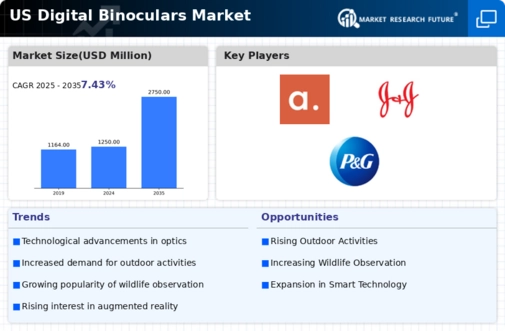Expansion of E-commerce Platforms
The digital binoculars market is growing significantly due to the expansion of e-commerce platforms., which facilitate easier access to a wide range of products. Consumers are increasingly turning to online shopping for convenience and competitive pricing. This shift is reflected in market trends, with e-commerce sales of digital binoculars projected to increase by 20% annually. The ability to compare features, read reviews, and access a broader selection of brands enhances consumer confidence in purchasing decisions. As e-commerce continues to evolve, it is likely to play a crucial role in shaping the future landscape of the digital binoculars market.
Growing Adoption of Smart Technology
The integration of smart technology into the digital binoculars market is becoming a pivotal driver of growth. Consumers are increasingly attracted to binoculars that offer connectivity features, such as Bluetooth and Wi-Fi, allowing for seamless sharing of images and videos. This trend aligns with the broader consumer electronics market, where smart devices are gaining traction. Market analysis suggests that the segment of digital binoculars equipped with smart technology is expected to account for approximately 30% of total sales by 2027. As users seek multifunctional devices that enhance their outdoor experiences, the demand for smart digital binoculars is likely to continue its upward trajectory.
Increased Focus on Outdoor Recreation
the digital binoculars market is growing due to an increased focus on outdoor recreation activities.. As more individuals prioritize health and wellness, outdoor pursuits such as hiking, camping, and birdwatching are becoming more popular. This trend is supported by market data indicating that outdoor recreation spending in the US has risen by 10% in the past year. Consequently, the demand for digital binoculars that enhance these experiences is likely to rise. Consumers are seeking products that not only provide superior optical performance but also offer durability and portability, further fueling the growth of the digital binoculars market.
Rising Popularity of Wildlife Observation
The digital binoculars market is benefiting from the rising popularity of wildlife observation among various demographics, including families and nature enthusiasts. This trend is supported by an increasing number of wildlife conservation programs and educational initiatives that encourage outdoor exploration. Market data indicates that sales of digital binoculars specifically designed for wildlife observation have increased by 15% over the past year. As more individuals engage in activities such as birdwatching and nature photography, the demand for specialized digital binoculars that cater to these interests is expected to grow, further propelling the market forward.
Increased Demand for Enhanced Viewing Experiences
The digital binoculars market is seeing increased demand for enhanced viewing experiences., driven by consumers seeking superior optical performance and advanced features. As outdoor activities gain popularity, individuals are increasingly investing in high-quality digital binoculars that offer features such as image stabilization, night vision, and digital zoom capabilities. This trend is reflected in market data, indicating that the segment of digital binoculars with advanced optical technology is projected to grow at a CAGR of 8% through 2026. The desire for immersive experiences in wildlife observation, birdwatching, and sports events is propelling this growth, as consumers prioritize products that enhance their visual engagement with the environment.













Leave a Comment